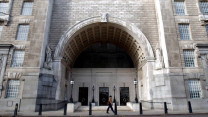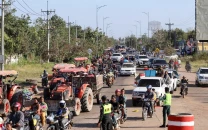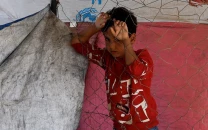Travel: Musings on the Mekong
Scarred by war and stifled by communism, the Vietnamese are now looking to the future.

Scarred by war and stifled by communism, the Vietnamese are now looking to the future.
The smell in the interior of the clubs, according to a visiting French correspondent, was one part perfume, one part perspiration and two parts Gauloise and Gitanne. In fact, the air was so thick with cigarette smoke you cut it with a stiletto. There was at times also the unmistakable whiff of incense, the clink of wine glasses as revelers offered toasts with the finest from the vineyards of Burgundy; as a clutch of spies and double agents, felt hats pulled low over their eyes, raincoats turned up at the collar, lurked in the shadows and spoke in hushed whispers. Heck, I simply had to see what eventually happened to the place.

Though I have visited every country in the Far East, Vietnam had somehow eluded me. For one thing, it’s jolly difficult getting a visa, and for another there is the language barrier. Nevertheless, I managed to cross all hurdles and finally landed in a country that had made a remarkable recovery after having suffered the ravages of war. First it was the French: and then the Americans. It was almost as if the Four Horsemen of the Apocalypse had galloped across this verdant land of rivers and forests and harvests of paddy that glistened in the hot sun…and left behind a depressing portrait of total destruction. I chose Ho Chi Minh City (formerly Saigon) over the capital Hanoi, because I wanted to see how a more cosmopolitan outpost of the former French empire had been transformed after the communist revolution.
To start with, there are nine million inhabitants and six million motor-cycles in the city! Flags with the five-pointed star and hammer and sickle in blazing red hang from lamp posts and tall buildings all over the town, a reminder to the visitor that he is in a communist country. But signs of a flourishing market economy are everywhere. In some ways, Vietnam follows the example of China where a communist government dictates policy while giving a friendly nod to the spirit of laissez-faire. But the resemblance stops there because China has become an industrial giant. The Vietnamese, however, are no ordinary people. They are resilient and dexterous and though on average short and of slim build, tough in their own way. They also have a fierce sense of nationalism.

The day after landing, my guide Nguyen Thi Bich Tuyen took me to the Cu Chi tunnels situated 70 kilometers west of Saigon. Now every tourist who visits Ho Chi Minh City simply has to see these subterranean passages built on three levels by male and female rice farmers who, rifle in one hand and plough in the other, were transformed overnight into guerillas. The first level was earmarked for fighting. The second had a hospital with medicines, living quarters, places where they could hold their meetings and where rice and tapioca could be stored. And the third level was for escaping from the enemy. I wondered about ventilation and what the diggers did with the earth they dug up, until my guide pointed to a cluster of what looked like anthills every few meters on the surface, with small holes cunningly cut into the sides near the base.

Vietnam is a relatively poor country when compared to Thailand, but the people still have a sense of pride and what is called true grit. The Vietnamese don’t talk about the war any more and would like to forget this terrible period in their history. They want their place in the sun. They are forward-looking and have extended a hand of friendship to all nations including the United States. Nevertheless, Cu Chi and the War Museum are being preserved specifically for the tourists — the former as a symbol of stubborn and unyielding resistance — and the latter as a supreme example of man’s inhumanity to man. In the War Museum two elderly Australian women broke down when they saw some of the pictures. But while I glossed over the tales of horror in black and white, I did also come across photographs of two American civilians Norman R Morrison and R Laporte who burned themselves to death outside the Pentagon to protest the atrocities that were being committed by their country’s soldiers. Turning to the husband of one of the Aussie women I said “Not all Americans are bad, mate. There were a hell of a lot who joined protest marches. And there were US helicopter pilots like Hugh Thompson and Lawrence Colburn who saved the lives of Vietnamese civilians during the My Lai massacre. It’s just the guys who shape the policies that are bad.”
My trip by motor-boat to the four islands of the Mekong Delta was most enjoyable. As we climbed into the boat, I noticed each of the vessels had a huge single eye painted on the side. This was because the mariners believe there are river monsters lurking in the depths and the big eyes are there to ward them off. The fishing boats, on the other hand, have no eyes painted on them. Lunch was served on the second island in a hut with a thatched roof, and consisted of crab soup, fried elephant-eye fish wrapped in rice paper, two large portions of fried chicken, the fruit of the season and tea. I used my chop sticks like a native and attacked the viands with gusto. Vietnamese food is supposed to be a blend of Chinese and French cuisine. All I know is that it is delicious.

While I relished the meal, my guide narrated to me a custom which is still apparently practiced in the country. If a married woman does not produce a child within the first three years of marriage she is sent back to her mother. There are no checks to find out if the man is impotent or if the woman has a problem which can be cured with medication. Well, there is an endearing story which has been turned into a popular song based on this theme…which, I am happy to say, has a happy ending. One of these unfortunate wives, who was apparently sterile, was still loved by her spouse who was most reluctant to give her up. So, instead of sending her back to her mother, he hid her with one of his relatives where he could secretly visit her. This cloistered sanctuary apparently did the trick, for the woman bore him eight fine children… and they lived happily ever after. The episode was turned into a folk song which became quite popular. And for a dollar, a rather plump woman, resplendent in bejeweled corpulence, accompanied by two musicians carrying native guitars, sang this song with a certain gusto which was quite fetching.
When it came to shopping, my guide told me it would be better if I did the bargaining, rather than she, well… because she lived on one of the islands and wanted to keep friendly relations with her neighbors. All the shops were managed solely by women. In one of the stalls, I was quite astonished to see a salesgirl who stood at least five feet ten inches in her sandals. She had freckles on her face and arms and could have passed off as a Lithuanian. She was also jolly attractive.
There was a droll moment when I had invited my guide to dinner one evening at the Indochine restaurant. It was a classy place. Tables were separated by a pool shaped like a lagoon (without the gondolas, of course) and four musicians played light classical music and folk songs There was a huge roar of applause from the Russian corner in which I heartily joined when the quartet played Kalinka Maya and Occhi Charneye. My guide, however, was very quiet and sullen. The cause turned out to be the behavior of the elderly waitress. “You see,” Tuyen pointed out, “when we had lunch in the Lion Restaurant in Cong Truong Lam Son, the staff knew I was your guide and were extremely friendly. But this is dinner, and the waitress thinks this is a courtship and I am trying to hook a rich European businessman.” I thought it was terribly funny and said so. The waitress was summoned, an explanation was offered and I saw one of the widest smiles I had ever seen this side of Alexandria.
Ho Chi Minh City has changed from the blood and thunder days when a nation fought for its survival, and seventeen-year old female guerrillas knocked out tanks with rocket launchers. The junks no longer fold their sails when the Mekong swallows a big red sun at evening, while hundreds of motor-cycles roar on the embankments and the shops bristle with the fruits of a growing industrial economy. But the countryside is still covered by blankets of emerald green tended by women in triangular straw hats; and once a month a pale full moon still cuts a jagged silver path on the Saigon River. I wouldn’t have missed this trip for anything.
Published in The Express Tribune, Sunday Magazine, March 17th, 2013.
Like Express Tribune Magazine on Facebook to stay informed and join the conversation.



















COMMENTS
Comments are moderated and generally will be posted if they are on-topic and not abusive.
For more information, please see our Comments FAQ